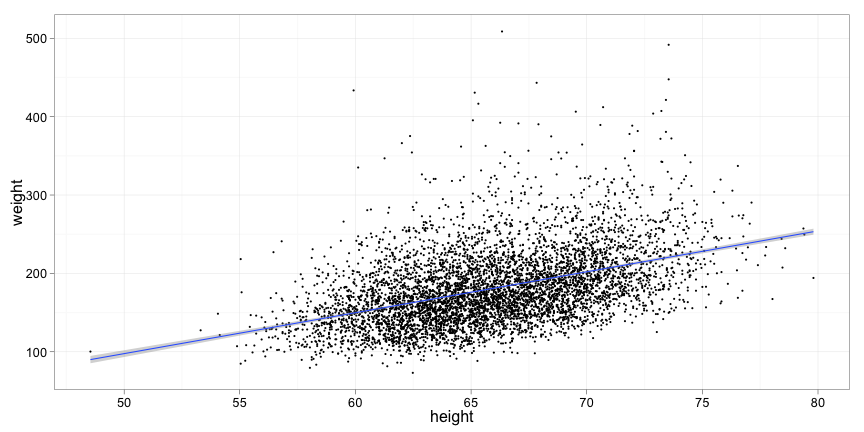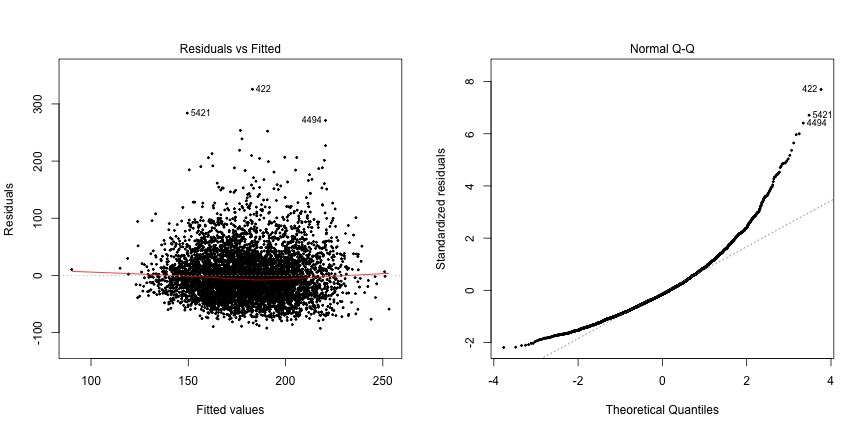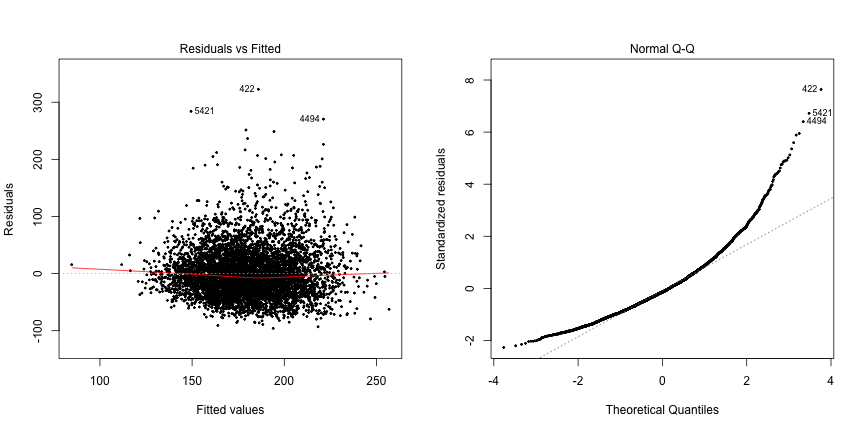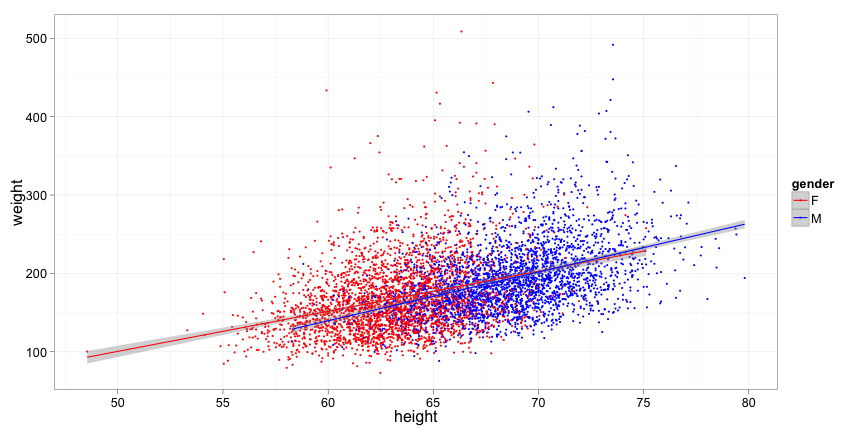Linear Regression in R
Kent S Johnson
http://kentsjohnson.com
May 2012
What is linear regression?
- Models the relationship between a continuous dependent variable \(y\) and one or more independent variables \(x\).
- Finds a straight-line fit between variables
- Why?
- Measure the strength of a relationship
- Understand the nature of a relationship
- Predict \(y\) for new values of \(x\)
Simple linear regression
- Models the relationship between a single independent variable \(x\) and a dependent variable \(y\).
- Independent variable may also be called an explanatory or predictor variable.
- Dependent variable may be called the response.
Example
What is the relationship between height and weight?
library(ggplot2)
data = read.csv("CDC_data.csv")
p = qplot(height, weight, data = data, size = I(1))
p + stat_smooth(method = "lm")
Source: CDC National Health and Nutrition Examination Survey 2009-2010
The linear regression model
Simple linear regression uses the model \[y_i = \beta_0 + \beta_1 x_i + \epsilon_i\]
- The \(y_i\) are the dependent variables
- The \(x_i\) are the independent variables
- \(\beta_0\) is the intercept of the line and \(\beta_1\) is the slope
- You may recognize this from linear algebra as the formula for a line
- \(\epsilon_i\) is the error term for each \(y_i\)—the difference between the actual \(y_i\) and the predicted value
- The error terms are assumed to be normal, independent and identically distributed
Finding the best line
Find the values for \(\beta_0\) and \(\beta_1\) that minimize the sum of squared errors \(\sum{\epsilon_i^2}\). This is the least squares fit.
In R this is done with the stats::lm() function.
lm() uses a formula interface to specify the dependent and independent variables.
The formula y ~ x means “y is modeled by x.”
In the example we want to model weight as a function of height so the formula is
weight ~ height
Example (cont)
model = lm(weight ~ height, data)
summary(model)
#
# Call:
# lm(formula = weight ~ height, data = data)
#
# Residuals:
# Min 1Q Median 3Q Max
# -92.7 -28.9 -6.3 21.4 325.7
#
# Coefficients:
# Estimate Std. Error t value Pr(>|t|)
# (Intercept) -163.233 8.882 -18.4 <2e-16 ***
# height 5.218 0.135 38.8 <2e-16 ***
# ---
# Signif. codes: 0 '***' 0.001 '**' 0.01 '*' 0.05 '.' 0.1 ' ' 1
#
# Residual standard error: 42.3 on 5992 degrees of freedom
# Multiple R-squared: 0.2, Adjusted R-squared: 0.2
# F-statistic: 1.5e+03 on 1 and 5992 DF, p-value: <2e-16
#
What?
The formula used to create the model:
# Call:
# lm(formula = weight ~ height, data = data)
Residuals are the error terms \(\epsilon_i\)—smaller is better:
# Residuals:
# Min 1Q Median 3Q Max
# -92.7 -28.9 -6.3 21.4 325.7
The coefficient estimates are the model parameters. (Intercept) is \(\beta_0\), the intercept of the line on the y-axis. height is \(\beta_1\), the slope of the line.
# Coefficients:
# Estimate
# (Intercept) -163.233
# height 5.218
In this model, an additional inch of height translates to 5.2 pounds weight.
Model statistics
The rest of the output is useful for evaluating the model. It includes
standard error, t-statistic and p-value for each coefficient
# Coefficients:
# Estimate Std. Error t value Pr(>|t|)
# (Intercept) -163.233 8.882 -18.4 <2e-16 ***
# height 5.218 0.135 38.8 <2e-16 ***
\(R^2\) value and F-statistic
# Residual standard error: 42.3 on 5992 degrees of freedom
# (65 observations deleted due to missingness)
# Multiple R-squared: 0.2, Adjusted R-squared: 0.2
# F-statistic: 1.5e+03 on 1 and 5992 DF, p-value: <2e-16
Confidence intervals
Confidence intervals on the model coefficients are another way to evaluate the model. The stats::confint() function computes confidence intervals for model coefficients.
confint(model)
# 2.5 % 97.5 %
# (Intercept) -180.645 -145.820
# height 4.954 5.482
Graphical evaluation of the model
Not all data is well represented by a linear model.
- Non-linear data, e.g. quadratic, exponential
- Error terms are not normal and independent
- Non-normal distribution
- Depend on prediction
- Non-equal variances
plot(model) creates diagnostic plots
Diagnostic plots
op <- par(mfrow = c(1, 2))
plot(model, which = c(1, 2), pch = 20, cex = 0.5)
Hmmm…
The diagnostic plots indicate that the errors are not normally distributed. They seem to be skewed toward the right, i.e. the tail is longer on the right. This is visible in the original plot as well.
In the real world, you might try transforming the data to get a better fit.
Predictions
The stats::predict() function is used to predict the \(y\) values for new values of \(x\).
Values for the independent variable are passed in a data frame column with the same name as the original data.
new_x = data.frame(height = c(60, 65, 70))
predict(model, new_x)
# 1 2 3
# 149.9 176.0 202.1
Predictions may include confidence intervals:
predict(model, new_x, interval = "prediction")
# fit lwr upr
# 1 149.9 66.9 232.8
# 2 176.0 93.0 258.9
# 3 202.1 119.1 285.0
Multiple regression
Multiple regression models the dependent variable as a linear combination of multiple independent variables.
For example, how does gender affect the relationship between height and weight?
The simplest case has no interactions between the independent variables: \[y_i = \beta_0 + \beta_1 x_{1i} + \beta_2 x_{2i} + ... + \beta_n x_{ni} + \epsilon_i\]
For height, weight and gender this becomes \[weight_i = \beta_0 + \beta_1 height_i + \beta_2 gender_i + \epsilon_i\]
The R formula is similar to the model: weight ~ height + gender
Example (cont)
model <- lm(weight ~ height + gender, data)
summary(model)
#
# Call:
# lm(formula = weight ~ height + gender, data = data)
#
# Residuals:
# Min 1Q Median 3Q Max
# -95.9 -28.9 -6.0 21.5 322.7
#
# Coefficients:
# Estimate Std. Error t value Pr(>|t|)
# (Intercept) -191.437 11.528 -16.61 < 2e-16 ***
# height 5.688 0.182 31.25 < 2e-16 ***
# genderM -5.665 1.479 -3.83 0.00013 ***
# ---
# Signif. codes: 0 '***' 0.001 '**' 0.01 '*' 0.05 '.' 0.1 ' ' 1
#
# Residual standard error: 42.3 on 5991 degrees of freedom
# Multiple R-squared: 0.202, Adjusted R-squared: 0.202
# F-statistic: 760 on 2 and 5991 DF, p-value: <2e-16
#
What?
The (Intercept) and height coefficients have the same meaning as before. The genderM coefficient models the difference in weight for a male and female of the same height. Surprisingly, in this model, males weigh on average 5.6 pounds less than females of the same height.
# Coefficients:
# Estimate Std. Error t value Pr(>|t|)
# (Intercept) -191.437 11.528 -16.61 < 2e-16 ***
# height 5.688 0.182 31.25 < 2e-16 ***
# genderM -5.665 1.479 -3.83 0.00013 ***
All three coefficients are significant—they contribute to the model.
The model statistics are similar before:
# Residual standard error: 42.3 on 5991 degrees of freedom
# (65 observations deleted due to missingness)
# Multiple R-squared: 0.202, Adjusted R-squared: 0.202
# F-statistic: 760 on 2 and 5991 DF, p-value: <2e-16
Diagnostics again
op <- par(mfrow = c(1, 2))
plot(model, which = c(1, 2), pch = 20, cex = 0.5)
Interaction terms (briefly)
Does the slope of the relationship between height and weight depend on gender? This is an interaction. The model for this is
\[weight_i = \beta_0 + \beta_1 height_i + \beta_2 gender_i + \beta_3 height_i weight_i + \epsilon_i\]
The R formula uses * instead of +: weight ~ height * gender
Example (cont)
model <- lm(weight ~ height * gender, data)
summary(model)
#
# Call:
# lm(formula = weight ~ height * gender, data = data)
#
# Residuals:
# Min 1Q Median 3Q Max
# -95.4 -29.0 -5.9 21.6 324.5
#
# Coefficients:
# Estimate Std. Error t value Pr(>|t|)
# (Intercept) -155.139 16.619 -9.34 <2e-16 ***
# height 5.114 0.263 19.47 <2e-16 ***
# genderM -78.289 24.010 -3.26 0.0011 **
# height:genderM 1.103 0.364 3.03 0.0025 **
# ---
# Signif. codes: 0 '***' 0.001 '**' 0.01 '*' 0.05 '.' 0.1 ' ' 1
#
# Residual standard error: 42.2 on 5990 degrees of freedom
# Multiple R-squared: 0.204, Adjusted R-squared: 0.203
# F-statistic: 510 on 3 and 5990 DF, p-value: <2e-16
#
```
# Coefficients:
# Estimate Std. Error t value Pr(>|t|)
# (Intercept) -155.139 16.619 -9.34 <2e-16 ***
# height 5.114 0.263 19.47 <2e-16 ***
# genderM -78.289 24.010 -3.26 0.0011 **
# height:genderM 1.103 0.364 3.03 0.0025 **
```
(Intercept) is the intercept for the line for femalesheight is the slope for females - on average, females weigh 5.1 pounds more for every inch of heightgenderM is the difference in intercept for malesheight:genderM is the difference in slope for males - on average, males weigh 5.1+1.1 pounds more for every inch of height
ggplot rocks!
p = qplot(height, weight, data = data, color = gender, size = I(1))
p + stat_smooth(method = lm) + scale_color_manual(values = c("red",
"blue"))



